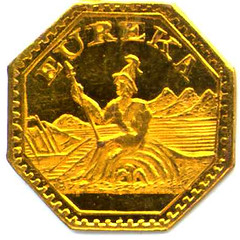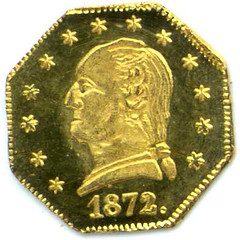
PREV ARTICLE
FULL ISSUE
PREV FULL ISSUE
FEATURED WEBSITE: CALIFORNIA GOLDThis week's Featured Web Site is Mike Locke's site on California fractional gold coins and tokens.
Although these small coins never acheived large scale circulation, by late 1853 they had gained popularity as souvenirs that could be economically mailed home. The gold content of these small coins started out rather low and once they became popular as souvenirs the weights dropped even farther. Congress passed 2 coinage acts in 1864 that effectively banned privately produced coins, but the law was not fully enforced until 1883. During the period of partial enforcement of the coinage act of 1864, one mint tried using gold rush era dates in order to avoid attracting attention. Although production was more-or-less stopped in 1883, it resumed in 1884 with pieces that lacked a dollar value claim on the design. These later pieces are called tokens by the collecting community. The backdating practice of 1864-1883 was adopted by most mints in the post 1883 time frame.
http://www.calgoldcoin.com/Wayne Homren, Editor The Numismatic Bibliomania Society is a non-profit organization promoting numismatic literature. See our web site at coinbooks.org. To submit items for publication in The E-Sylum, write to the Editor at this address: whomren@gmail.com To subscribe go to: https://my.binhost.com/lists/listinfo/esylum All Rights Reserved. NBS Home Page Contact the NBS webmaster 
|


